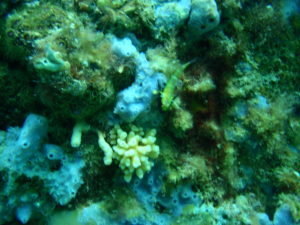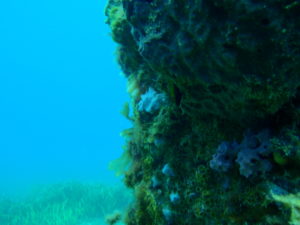In November 2013, I hosted Vasilis Gerovasileiou from Greece during his visit to South Australia. We only managed one dive together though. We managed a dive at Rapid Bay jetty on16th November 2013. Vasilis had only brought a 5mm wetsuit with him for his dives in Australia. This suit probably served him well for dives in WA & Queensland, but it didn’t work out so well for his dive in SA. The water temperature at Rapid Bay in November was just 17°C. This resulted in Vasilis avoiding any further dives that day or the following weekend.
16th November was a good day though. It was sunny and the sea was flat calm at Rapid Bay. Visibility in the water was excellent. We had 69 minutes of bottom time for our dive. Vasilis was hoping to see a seadragon during the dive, but that didn’t happen. We did manage to see a cormorant dive down a couple of times and we also saw a sea lion after the dive.
The 17°C temperature of the water, in conjunction with his 5mm suit, convinced Vasilis to cancel any further dive plans.
He was completing a PhD regarding sponges at the time, so we had spent much of our dive observing and photographing the sponges growing in the area.
Vasilis attended our General Meeting that month. I took him down to the South Coast the following weekend, but I couldn’t persuade him to don his dive gear again. He had already done some dives in WA, including at Rottnest Island, and he was looking forward to diving in Queensland still.
Vasilis returned back to Greece at the end of his Australian trip and he soon graduated. He then had to find some paid employment, which he eventually did. We maintained contact via Facebook before, during and after his trip.
According to his Facebook page, Vasilis is a former Research Fellow at Aristotle University of Thessaloniki and he studied PhD in Marine Biology at Τμήμα Βιολογίας ΑΠΘ. The page also says that he works at the Hellenic Centre for Marine Research.
On 1st September, whilst I was interstate, I came across this Facebook posting by Vasilis :
“We have reached 111 observations from coralligenous sites in Greece, Turkey, Italy, France, Algeria and Morocco by citizen scientists and collaborating experts! Participate to our new citizen science initiative and contribute to the exploration and the conservation of the coralligenous habitats and the marine environment! At the same you can increase your knowledge about Mediterranean marine biodiversity!”
The post had a link to http://cs.cigesmed.eu/ . The web page found there read:
“Welcome to CIGESMED for Divers – CIGESMED’s goal is to understand the links between natural and anthropogenic pressures and ecosystem functioning to define and maintain the Good Environmental Status (GES) of the Mediterranean Sea, by studying the typical, complex and not well known habitats built by calcareous encrusting algae, the “coralligenous”
“An integrated approach will be applied to share and visualize large datasets, and to manage the knowledge necessary to study coralligenous habitats. Indicators, from communities to infra-specific level (DNA), will be co-constructed and tested by scientists, Marine Protected Areas and reserves, and through the implementation of a “citizen science” network. The outcome will be an integrative assessment of the GES within the Marine Strategy Framework Directive (MSFD).
“CIGESMED gathers scientists from France, Greece and Turkey, making it possible to access to sites and to work on the same issues in both the northwestern Mediterranean basin and the Aegean-Levantine one. Ten laboratories of marine ecology are involved. It will also involve observers from other Mediterranean countries. It is coordinated by the IMBE (Mediterranean Institut of marine and terrestrial Biodiversity and Ecology), a unit of research of CNRS-INEE, Aix-Marseille University, IRD and the University of Avignon.”
I shot off an enquiry to Vasilis, saying “Can the project apply in South Australia ‘s Gulf St Vincent?” Vasilis’s reply was, “Unfortunately not at the moment because these formations/communities are exclusively found in the Mediterranean Sea (not even in the nearby Atlantic!) but would be great if you could tell us your opinion on the website and overall initiative. I know you have participated in other citizen science initiatives (e.g. Reef Watch) and we would be glad to have your feedback.”
According to the Facebook page found at https://www.facebook.com/cs4cigesmed/ , “The Coralligenous Observatory – Citizen Science for CIGESMed – A citizen science observatory for divers who want to contribute to coralligenous habitats’ monitoring and conservation”.
According to the web page found at http://cs.cigesmed.eu/en/node/21 , “CIGESMED: Coralligenous based Indicators to evaluate and monitor the “Good Environmental Status” of the MEDiterranean coastal waters”.
Also found at http://cs.cigesmed.eu/en/node/21 :
“What is “coralligenous”?
What is commonly called coralligenous is, actually, a complex seascape (i.e. a submerged landscape) developing in dim light conditions, which is present exclusively in the Mediterranean Sea. Coralligenous habitat is mainly created by calcified red algae, which are constructing reef-like structures for thousands of years over marine rocky bottoms. In this respect coralligenous formations are considered to be the Mediterranean equivalent of the tropical coral reefs. At the same time, some other organisms- which are called ‘eroders’ – such as sponges of the genus Cliona or sea urchins pierce and consume the calcareous substrate and thus contribute to increase the structural complexity of the coralligenous formations. This calcareous substrate also supports several long-living species (sponges, gorgonians, bryozoans, corals), which are contributing to the structuring of the coralligenous habitat. Finally, a large number of invertebrates (such as nudibranchs, crustaceans, ascidians, echinoderms, molluscs) and fishes are associated with coralligenous habitats, a fact which further contributes toward the characterization of the coralligenous habitat as a unique biodiversity hotspot.
Why do we observe coralligenous habitats?
They are unique habitats worldwide and among the richest and most beautiful seascapes to observe during scuba diving. Thanks to their complexity, they shelter a great number of ecologically, aesthetically and commercially valuable species, some of which are also protected by National and International Laws. Coralligenous habitats are often threatened by the human behaviour. Intense anchoring, irresponsible diving, (over)fishing, litter dumping, alongside with sea surface warming (due to climatic change) and alien species invasions, are among the main threats which can induce negative effects on the health status of coralligenous habitats.
By participating into the CIGESMED for divers activity you contribute to the exploration and the conservation of the coralligenous habitats and the marine environment while at the same you can increase your knowledge about the marine biodiversity.”
Another one of my photos taken that day in November 2013



